
Case Report
A Case Report. J Dent App. 2015;2(3): 174-177.
Bone Ring Autogenous Graft Transplantationing one Stage Technique and Early Implant Placement: A Case Report
Elif Oncu*
Necmettin Erbakan University Departmant of Periodontolgy
*Corresponding author: Dr. Elif Oncu, Necmettin Erbakan University Departmant of Periodontolgy, Karacigan Mah, Ankara Cad, No: 74/A Karatay / Konya
Received: October 23, 2014; Accepted: February 03, 2015; Published: February 05 , 2015
Abstract
Treatment of edentulous regions through dental implants is getting harder depending on bone resorption that arises on alveolar bone, after the removal of serious periodontal defected tooth. A wide selection of methods are applied with the purpose of bone augmentation for implant treatment. A 6-month-period of recovery is needed for bone and graft substitution after the process of bone reconstruction used when there is insufficiency of vertical and/or horizontal ridge. Called ring method, ridge augmentation and implant placement in one session reduces treatment period and the number of surgery.
Introduction
Implant procedure in routine practice and autogenous block bone grafts are applied for alveolar ridge reconstruction in wide threedimensional bone defects in edentulous spaces. Taken from intraoral or extra-oral donor sites, autogenous block bone grafts might be free cancellous or corticocancellous. Autogenous grafts contain a variety of living cells and growth factors that have osteoinductive, osteoconductive and osteogenic effects [1-3].
The remaining bone morphology is vital to implant placement on aesthetic region. After advanced periodontitis, serious bone resorption might be seen around the teeth, which consequently makes implant placement difficult on these regions following tooth extraction. Before implant placement, bone augmentation procedures are routinely needed, so the horizontal and vertical extent of the defect plays a vital role in the use of the bone augmentation applied to reconstruction of these ridge defects [5]. Taken from the symphysis, block bone grafts can be applied for predictable bone augmentation which is up to 6 mm in horizontal and vertical dimensions [6,7].
It is possible for the surgeon to augment the bone and insert the implant in one session using the bone ring transplantation procedure developed by Bernhard Giesenhagen in 2004 [4,5].
The fact that autogenous block bone grafts have osteoinductive, osteoconductive and volume enhancement properties makes them ideal for the reconstruction of three-dimensional alveolar bone defects. Bone integration, however, requires at least a three-month recovery period after osseous reconstruction. On the one hand, it can be said that the treatment period is raised by a second operation and recovery period when dental implants are taken into consideration. On the other, treatment period and the number of operations is shortened by “ring technique” which is used as single stage crest augmentation with simultaneous implant placement [8].
Using not only early implant placement but autogenous bone graft in the same time along with graft in the shape of “bone ring” taken from the symphysis, this article gives a definition to a surgical technique of restoring maxillary lateral region.
Material-Method
In the clinical examination of the 45-year-old male patient, who had gingival recession on the maxillary right lateral, who was systematically healthy and did not smoke, the second degree of gingival recession in the buccal region and vertical and horizontal mobility on that tooth was diagnosed (Figure 1). When radiographically examined, vertical and horizontal bone loss around the tooth was seen (Figure 2), so the removal of the teeth and the placement of ring shaped bone graft harvested from symphysis region with passive intra-bone implant on defect region after the healing of soft tissue were decided to perform.

Figure 1: Gingival recession on the maxillary right lateral.

Figure 2: Preoperative radiographic view of the patient.
The patient signed consent form about the treatment content and possible complications.
Surgcal Procedures
A week before the surgery tooth was extracted without trauma and satisfactory healing was seen after 1 week (Figure 3a, 3b).
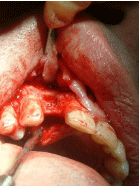
Figure 3b: A week after tooth extraction
The patient rinsed their mouths with 0.12% chlorhexidine gluconate for 30 seconds just before surgery. Local anesthesia was applied during the procedure (articaine hydrochloride 4% with epinephrine 1:100 000). ). In recipent region a full-thickness flap with vertical releasing incisions were reflected. Once the bone in the symphysises region had been exposed, a slight touch with a rotating trephine cutter defined the donor site of the bone transplant, with the cutter being one size larger than defined at the augmentation or recipient site (Figure 4). The implant beds in socket were prepared following the usual protocol, using a pilot drill, depth drills and – for the Ankylos implant system (Ankylos implant system, Dentsplay) used and depicted here – also reamers and bone taps. It is very important to penetrate substantially the spongious bone of the donor region. In order to facilitate the removal of the bone ring (Figure 5), the bone transplant was prepared to its definitive depth using the trephine cutter. Sharp edges were identified and gently rounded by low speed fissure bur under copious saline irrigation. The bone rings graft that were taken from chin, were placed in the implant cavity . Ring graft was stabilized with implant ( diameter 3.5 mm, length 14 mm) (Figure 6). The bone chips collected during preparation and collected in the patient’s own blood were used to fill up the basal cavities. The remaining cavities have to be filled up with bone substitute and platelet rich fibrine. The entire grafting area was covered with a platelet rich fibrine (Figure 7) and large screw plug was placed for stability. The wound was sutured using the coronally advanced flap technique.

Figure 4: Symphyseal bone cylinder harvested from the chin
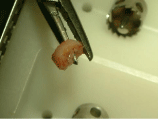
Figure 5: Bone rings after removal from the symphysis.

Figure 6: Bone cylinder, placed with the help of dental implant into the bone
defect.

Figure 7: The entire grafting area was covered with a platelet rich fibrine.
Treatment Outcome
The implant became osseointegrated without any dehiscence, graft exposure and infection on the bone and soft tissue around the implant (Figures 8, 9). Six months later, healing cap surgery was performed after panoramic examination (Figures 10, 11). One week later, a definitive crown was successfully placed (Figure 12). The patient showed satisfaction with the final prosthesis.

Figure 8: Six months later, clinical view of surgery grafted area.
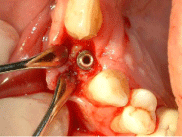
Figure 9: Six months later, clinical view of surgery grafted area.
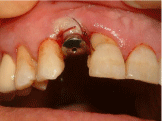
Figure 10: Six months later, healing cap surgery was performed.

Figure 11: Postoperative panaromic radiograph after 6 months.
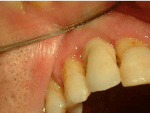
Figure 12: Final restoration.

Figure 13: Postoperative radiographic view after 2 years.
Neither clinical nor radiographic problems or complications (graft resorption, implant mobility) occured during the 2-year-period when the implant was followed after restoration (Figure 13).
Discussion
The treatment performed with intra-oral autogenous block graft is one of the best methods to increase the insufficient bone volume on the region where implant is to be placed. The reconstruction of alveolar defects with autogenous block graft is considered to be the gold standard [9]. However, this treatment requires two different surgical procedures and takes much time. In this case report, the second surgical operation was not required due to autogenous onlay graft harvested from symphysis 1 week after tooth extraction and dental implant placement in the same session, which allowed to reduce the treatment time. With the bone reconstruction in the same session with the implant placement, possible bone resorption can be prevented [10]. Thin residual bone remaining in the buccal region after tooth removal is quickly resorbed, but socket preservation is successfully performed due to the reconstruction of socket with onlay graft [11].
Symphysis region is easily accessible to harvest autogenous block graft, and a low degree of morbidity and minimal graft resorption is observed on the region [12]. More limited amount of bone can be harvested from symphysis region than ramus region and postoperative sensitivity can be monitored in mandibulary anterior teeth. Though there are investigations that show postoperative complications of ramus grafts are lower than those of symphysis grafts, no complication was observed as a result of harvesting symphysis graft in this case report [13,14].
Mark R. Stevens et al. placed three-dimensional bone ring block graft with combined dental implant on the sockets in the same session with the removal of maxillary anterior 4 tooth. At the same time all the implants were successfully osseointegrated. During the healing period, after the operation, no complications or problems like infection or bone resorption were observed [15]. Likewise, we decided to use a one-stage protocol, and bone augmentation with implant osseintegration was successfully performed without any postoperative complications.
Jordan A. et al. used autogenous block graft to reconstruction of insufficient anterior maxillary alveolar bone before implant placement on 14 patients. They prefered a 2-stage procedure, placing the implants after successfully performing augmentation on maxillary anterior region, however, we prefered a one-stage procedure and successfully performed augmentation [16]. Moreover, it enabled us to shorten the operation time, with no second operation required.
While harvesting graft from symphysis region, it is very important to be take the thickness of graft and the distance to mandibular anterior teeth into account. Because limited amount of graft can be harvested, it might be broken or may lead to contour disorder on the mentum if harvested in excessive amount [13-15]. While determining the donor site boundaries, they have to be 5 mm away from the roots not to damage the roots of anterior teeth. Similarly, in this investigation, we inserted ring block graft boundaries minimum 5 mm away from the teeth with terephine bur.
In order for autogenous block graft to be successfully performed, its stabilization on recipient site is vital. Such methods as screw or plate fixation are applied to have successful stabilization of block grafts harvested from block intra-oral or extra-oral site, and these materials have to be removed through the second surgical operation. In the technique we used, autogenous bone was prepared in suitable size for the defect in recipient site and it was adapted by tapping on defect region. Its primer stabilization was performed by fixing on defect region through implant. Consequently, no second operation was needed for removal of the screw.
References
- Misch CE, Dietsh F. Bone-grafting materials in implant dentistry. Implant Dent 1993; 2: 158-167.
- Marx RE. Clinical application of bone biology to mandibular and maxillary reconstruction. Clin Plast Surg 1994; 21: 377-392.
- Cordaro L, Amade DS, Cordaro M. Clinical results of alveolar ridge augmentation with mandibular block bone grafts in partially edentulous patients prior to implant placement. Clin Oral Implants Res 2002;13:103-111.
- McCarthy C, Patel RR, Wragg PF. Brook IM. Dental implants and onlay bone grafts in the anterior maxilla: analysis of clinical outcome. Int J Oral Maxillofac Implants 2003;18:238-241.
- Tekin U, Kocyigit D, Sahin V. Symphyseal Bone Cylinders Tapping With the Dental Implant Into Insufficiency Bone Situated Esthetic Area at One-Stage Surgery: A Case Report and the Description of the New Technique. Journal of Oral Implantol 2011;5:589-594.
- Yüksel O, Giesenhagen B. Vertical augmentation and implant placement in just one operation: a case report. Tissue Care NEWS 2010;1:1-6.
- Stevens MR, Emam HA, Alaily ME, Sharawy M. Implant bone rings. One-stage three-dimensional bone transplanttechnique: a case report. J Oral Implantol 2010; 36:69-74.
- Pikos MA. Mandibular block autografts for alveolar ridge augmentation. Atlas Oral Maxillofac Surg Clin North Am 2005;13:91-107.
- Zouhary KJ. Bone graft harvesting from distant sites: Concepts and techniques. Oral Maxillofac Surg Clin North Am 2010;22:301-316.
- Barzilay I. Immediate implants: their current status. Int J Prosthodont 1993;6:169-175.
- Schropp L, Kostopoulos L, Wenzel A. Bone healing following immediate versus delayed placement of titanium implants into extraction sockets: a prospective clinical study. Int J Oral Maxillofac Implants 2003;18:189-199.
- Nkenke E, Schultze-Mosgau S, Radespiel-Troger M, Kloss F, Neukam FW. Morbidity of harvesting of chin grafts: a prospective study. Clin Oral Implants Res. 2001:12;495-502.
- Misch CM. Ridge augmentation using mandibular ramus bone grafts for the placement of dental implants: Presentation of a technique. Pract Periodontics Aesthet Dent 1996;8:127-135.
- Schwartz-Arad D, Levin L. Intraoral autogenous block onlay bone grafting for extensive reconstruction of atrophic maxillary alveolar ridges. J Periodontol 2005; 76:636-641.
- Stevens MR, Emam H A, Alaily M E, Sharawy M. Implant Bone Rings. One-Stage Three-Dimensional Bone Transplant Technique: A Case Report. Journal of Oral Implantol. 2010;36:69-76.
- Greenberg JA, Wiltz MJ, Kraut RA. Augmentation of the Anterior Maxilla With Intraoral Onlay Grafts for Implant Placement. Implant Dentistry. 2012; 21: 21-24.